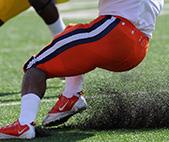Synthetic Turf/Recycled Tire Crumb Rubber

Research Overview
Status: Completed
Substances:
Crumb Rubber
Nominated:
November 2015
Background Information
Synthetic turf fields are frequently used within the United States. A standard synthetic turf field uses infill materials, such as crumb rubber, which is spread between the fibers to provide cushioning and traction. In recent years, the use of tire crumb rubber has led to public concern for potential health risks, as athletes and children dive and play on these surfaces and may be exposed to chemicals with unknown health effects.
NTP Studies & Findings
NTP has conducted research to enhance the understanding of the chemicals released from synthetic turf with an emphasis on the crumb rubber and the potential for health impacts.
What did the studies find?
Though these studies lay the groundwork for future studies, they did not assess the health effects of long-term exposure to crumb rubber or evaluate carcinogenicity of chemicals in crumb rubber.
- There was no evidence of toxicity in mice from ingestion of crumb rubber. Analysis of the animals’ blood and urine showed that internal levels of crumb rubber chemicals were very low. No health problems were observed.
- For tests using human cells, NTP found that crumb rubber, under certain experimental conditions such as high heat, leached chemicals, some of which caused cell death.
- The NTP studies did not assess individual chemicals of crumb rubber, although they did confirm that it contains many substances, such as polycyclic aromatic hydrocarbons (PAHs), metals, plasticizers, such as phthalates, and bisphenol A (BPA).
You will find the full details of NTP's studies in the linked Research Reports below.
| Studies | Description | Findings |
|---|---|---|
| Chemical and physical characterization |
Identification of chemical composition and physical parameters of the crumb rubber used in NTP in vitro and in vivo studies. |
Chemical and Physical Characterization of Recycled Tire Crumb Rubber
|
| In vitro tests |
Cell-based tests assessing the availability of substances to interact with cells, due to leaching out of the original material, and their biological effects in human-derived cell lines:
|
Characterization of the Cytotoxicity of Crumb Rubber In Vitro
|
| Feasibility to conduct in vivo studies |
Feasibility testing of in vivo studies by various routes of exposure:
|
Feasibility Study in Support of Non-Inhalation In Vivo Exposures of Synthetic Turf/Recycled Tire Crumb Rubber
|
| Female mouse 14-day |
Short-term in vivo studies assessing the potential for systemic exposure to crumb rubber constituents. Exposure routes include:
|
14-Day Exposure Characterization Studies of Crumb Rubber in Female Mice Housed on Mixed-Bedding or Dosed Via Feed or Oral Gavage
|
Research at Other Agencies
United States
- Environmental Protection Agency
- Consumer Product Safety Commission
- California Office of Environmental Health Hazard Assessment
Informational Resources
FAQ
Q: Why is crumb rubber a concern?
A: As athletes and children dive and play on these surfaces, crumb rubber particles have been found to cling to clothing, skin, or hair. This can lead to unintentionally inhaling, ingesting, and skin contact with the crumb rubber or with chemicals that may leach out of it. At this point, the health effects of exposure to crumb rubber are unknown.
Q: What is crumb rubber made from?
A: This crumb rubber consists of shredded rubber particles made from recycled automotive tires and is often mixed with sand.
Q: Is it safe for children to play on surfaces made of crumb rubber?
A: The NTP studies did not answer that question. This study only showed that very little of the constituent chemicals leach from the crumb rubber and that virtually none of the crumb rubber entered into the animals through skin absorption or even by eating the material.
Q: Are there concerns about chemicals in crumb rubber?
A: The chemicals of interest or concern are used in tire manufacturing. They range from polyaromatic hydrocarbons (PAHs) in carbon black to zinc oxide (ZnO), which is used as a hardening agent and could contain trace amounts of lead and cadmium oxides. Other chemicals used in tire manufacturing, include sulphenamides, guanidines, thiazoles, thiuams, dithiocarbamates, sulfur donors, phenolics, phenylenediamines, and others.
Q: Can these chemicals get released from the crumb rubber on hot summer days or after wear-and-tear from playing sports?
A: It is possible that small amounts of the chemicals could be released, but more research is needed to understand if this is associated with any negative health effects.
Q: The NTP put crumb rubber into the bedding of the mice. Did you determine if the crumb rubber chemicals were absorbed through the skin?
A: No, our studies focused on health effects after ingestion, which represents a worst-case exposure scenario. We did not see any negative health outcomes after the mice ingested crumb rubber.
Q: Would you let your child play on a field made of Recycled Crumb Rubber Tires?
A: Research does not show an increased health concern from synthetic fields; however, additional studies such as a risk assessment are still needed, especially on exposure to PAHs through inhalation.
Concerned individuals and community members are encouraged to explore the websites on crumb rubber from the U.S. Consumer Product Safety Commission and the U.S. Environmental Protection Agency (EPA) to review the research results available to date. In addition, concerned individuals can check their state’s public health agency websites to determine if there are state-specific recommendations. The U.S. EPA has compiled a list of informational sources from state government websites.
Stay Informed & Contact Us

Stay Informed
Subscribe to receive email to stay informed about synthetic turf/recycled tire crumb rubber research and other NTP information.
Contact Us
For questions or additional information, email us or use our contact form.

